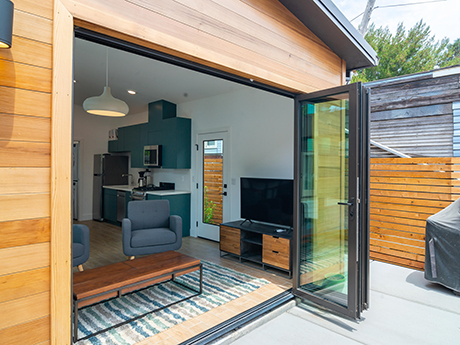By Brandi Campbell Wood
Forward-thinking multifamily developers are rediscovering a housing type that predates modern zoning: accessory dwelling units (ADUs).
An ADU is defined as a smaller, independent residential unit located on the same lot as a detached single-family home, according to the American Planning Association, a nonprofit organization that supports the field of urban and regional planning.
What was once commonplace in early 20th-century developments — garden cottages, cluster housing and secondary units within larger properties — is experiencing a renaissance driven by new policy opportunities and compelling financial returns.
Before World War II reshaped American neighborhoods, ADUs were woven into the fabric of residential development. Large houses routinely included smaller units, such as carriage houses, that provided income for property owners. And “cottage courts,” small detached or semi-detached rentals typically no larger than 10 units, offered gentle density that felt natural to the community.
This housing diversity was practical, economical and perfectly normal until postwar zoning transformed the landscape. Single-family exclusionary zoning eliminated what had been a natural part of the housing ecosystem and replaced it with a rigid suburban model that separated uses and standardized lot sizes.
Now, facing an unprecedented housing shortage, communities are rediscovering what previous generations understood. ADUs can be delivered in low density that works in almost any residential context, from urban infill or rural communities. They offer flexibility that serves multiple generations and changing household needs by housing family members, generating rental income and enabling aging in place.
For multifamily and affordable housing developers, ADUs aren’t experimental. They are time-tested solutions that modern policy is resurrecting.
California’s Advantage
California’s progressive ADU legislation has created new opportunities for homeowners and multifamily developers. Since 2016, the state has systematically removed barriers to ADU development, and the results speak volumes: ADU permits have jumped from fewer than 1,000 annually 10 years ago to more than 26,000 units in 2023, representing 21.3 percent of all new housing permits statewide.
But here’s what many developers don’t realize: California law has increased the number of ADUs on multifamily properties by 25 percent. This is essentially a built-in density bonus that can significantly improve project economics. Consider a 30-unit apartment complex where six ADUs rent for $2,200 monthly. That’s $158,400 in additional annual revenue that can improve debt service coverage ratios by 15 to 20 percent and increase net operating income (NOI) significantly. When you’re already purchasing materials in bulk and managing construction at scale, the marginal cost of adding ADUs becomes highly attractive.

Near San Diego, a joint venture between Westview Real Estate and Pace Properties added four new ADUs to a 17-unit apartment community at 330 S. Horne St. in Oceanside, which was built in 1970. The average unit size is 715 square feet, and amenities include a surf shower, secure electric bike parking, a grilling area and Los Angeles-inspired artwork featured throughout the community. An ADU at the property was listed for rent in 2024 at $2,195 per month.
As part of a $16.5 million renovation project by Santa Barbara, California-based Ocean Ten LLC, the Highlands, a 121-unit community in the Los Angeles suburb of Torrance, added 14 ADUs before it was purchased by Koto Estates Co. Ltd., an investor based in Japan, for $71.5 million in 2024. Units come in studios, one-, two- and three-bedroom floor plans, with ADUs renting at $2,575 per month.
While not every market offers California’s flexibility, the fundamental economics of ADU development — additional revenue streams, improved project economics and enhanced community appeal — make them attractive in virtually any jurisdiction that permits them.
ADUs Gain Momentum Beyond California
The ADU opportunity isn’t limited to California. Oregon pioneered early ADU-friendly policies, and now Colorado, Massachusetts, Washington, Utah, Arizona, Maine and Arkansas are joining the movement. Even Canada is embracing ADUs as part of its comprehensive housing strategies. Here are two examples.
Starting in 2020, the City of Portland, Oregon, implemented reforms with the goal of producing more duplexes, triplexes, fourplexes and cottage clusters in single-family zones. Since the Residential Infill Project passed in 2021, the city has permitted more than 1,400 ADUs. Not counting ADUs, fourplexes were the most common middle housing type, with cottage clusters more commonly permitted in the first half of 2024.
In 2023 and 2024, the average sales price of a new market-rate unit was about $250,000, less than that of a new single-family detached house, mostly due to size differences.
In March 2025, the city held meetings with developers of multifamily housing to identify opportunities to spur housing production, as high construction costs and market conditions present immense challenges to building homes in Portland and across Oregon. On May 1, the city announced it would waive system development charges, which are approximately $20,000 per housing unit, for three years to spur development of 5,000 new housing units over the next three years.
Minneapolis took a broader approach, allowing triplexes and ADUs by right in all neighborhoods through zoning reform in its 2040 Plan. This has encouraged both traditional developers and mission-driven organizations to add missing-middle housing and multigenerational units to their portfolios.
Infill Development Opportunities
Transit-oriented development sometimes presents attractive ADU opportunities. Seattle’s elimination of off-street parking requirements for ADUs in transit-rich areas has enabled property owners to convert underutilized spaces into housing. For multifamily developers, this creates opportunities to add density without the traditional parking infrastructure costs.
In Chicago, BLDG Projects and the Grace Street Renovation Lab are planning a multifamily building renovation project that will add an ADU. The plans call for adding a new top-story frame ADU to the existing three-story building and basement on a 5.4k-square-foot lot, raising the total dwelling units from five to six.
In Los Angeles, developers are acquiring unusual midcentury buildings known as “dingbats” — usually boxy, flat-roofed buildings in clusters of six to 12 units — and replacing their carports with ADUs, demonstrating adaptive reuse strategies.
Navigating Regulatory and Funding Landscapes
Understanding local zoning and ADU-specific codes is crucial for successful implementation. While many cities are amending zoning codes to allow ADUs in multifamily zones, rules vary significantly, particularly around detached versus internal ADUs and maximum unit limits.
Many jurisdictions require ADUs in multifamily developments to comply with International Building Code standards rather than the less stringent International Residential Code. These requirements affect project timelines and budgets.
ADUs may not always be recognized in traditional underwriting, but several states and municipalities now offer substantial financial incentives for ADUs, especially when they are deed-restricted like affordable housing.
California’s CalHFA program has provided up to $40,000 in grants for predevelopment costs, while Maryland allows property tax abatements for properties maintaining 25 percent affordable units.
San Diego offers density bonuses and fee waivers for ADUs on multifamily sites when a percentage are rented at affordable rates, enabling developers to exceed standard unit caps. These incentives can significantly improve project economics for developers willing to include affordable components.
While the City of San Diego recently rolled back some ADU regulations to cap the number of ADUs that can be built on single-family lots, it also became the largest city in California to approve a policy allowing ADUs to be sold separately from the primary home via condominium conversion.
This follows San Jose’s implementation in 2024, demonstrating how policy innovation can unlock new revenue streams for multifamily developers while providing more affordable homeownership opportunities.
The Developer’s Competitive Advantage
While competitors overlook these opportunities, forward-thinking developers who understand ADU opportunities can gain significant competitive advantages. In markets where ADU development is permitted but not widely understood, developers can:
● Secure better land deals by recognizing additional development potential
● Improve project economics through additional rental income
● Differentiate projects in competitive markets
● Access additional funding sources and incentives
● Build relationships with municipalities seeking housing solutions
ADUs represent a significant opportunity for multifamily developers who understand the regulatory landscape and can execute effectively. While not every project will benefit from ADU integration, developers who ignore this opportunity may be leaving money on the table. The housing shortage demands innovative solutions, and ADUs offer a path to increased density, improved project economics and community benefit.
Brandi Campbell Wood is principal and ADU programs director at Community Planning Collaborative, a Berkeley,California-based community development and urban planning firm that specializes in housing policy and ADU resources.


